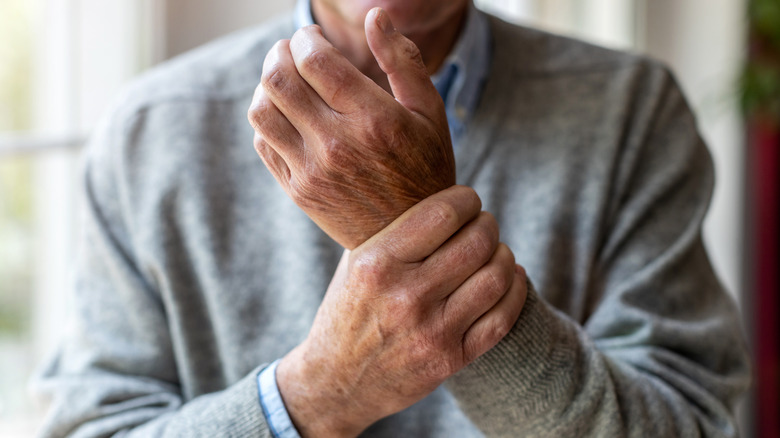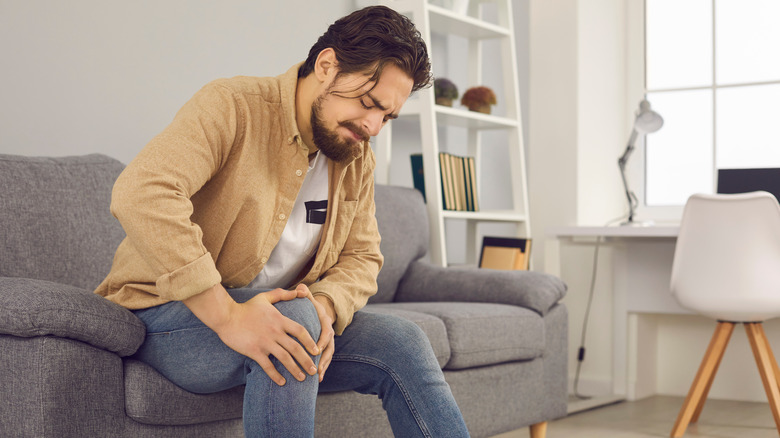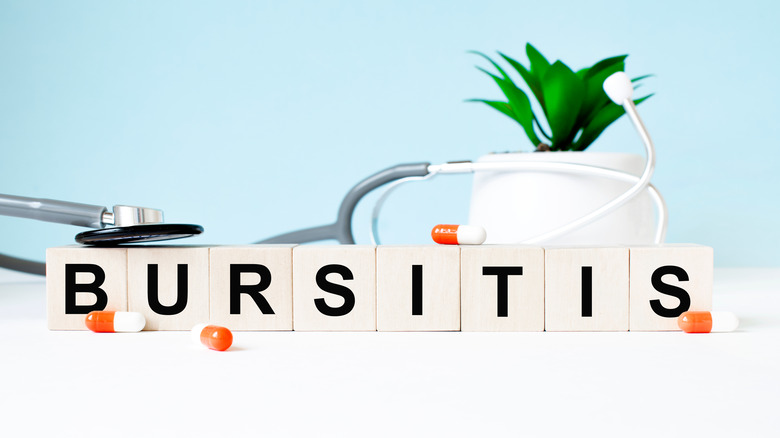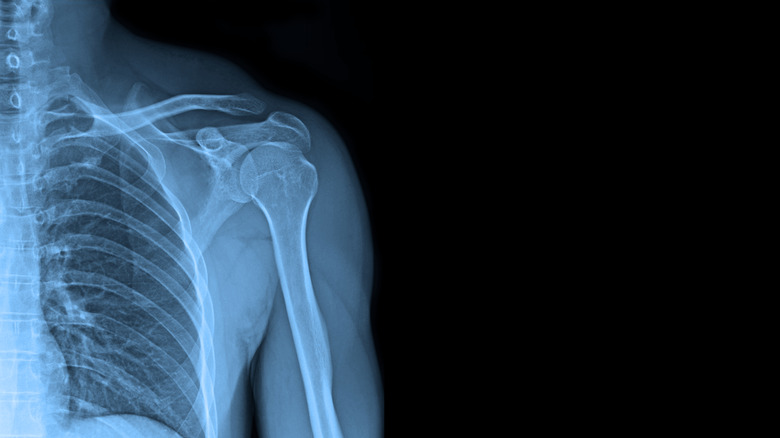This Is What Really Causes Stiff Joints
Your joints are made up of two or more bones and cartilage that protects the bones from rubbing together. There is also a joint capsule and synovial fluid, also known as joint fluid. A tissue called synovial membrane produces synovial fluid to keep the joint lubricated. Ligaments are an elastic type of connective tissue that controls joint movement. Tendons, another connective tissue, connect the bone to the muscle (via Stanford Children's Health).
You have joints all over your body — your fingers, wrists, elbows, shoulders, hips, knees, ankles, and toes — and they are all susceptible to stiffness. Joint stiffness can feel like you can't move your joints as much as you used to, and it often comes with pain or swelling. Joint stiffness is your body's way of telling you something is wrong, or a sign of a health condition, usually accompanied by other symptoms (via MedicineNet).
One common cause of joint stiffness is aging. According to WebMD, the cartilage in your joints starts to stiffen and dry out as you get older. As a result, your body will not make as much joint fluid — called synovial fluid — as it used to, causing difficulty in your joint range of motion. Unfortunately, the only way to get your body to make more fluid for your joints is to exercise.
Aging isn't the only cause. Many other health conditions can cause joint stiffness.
Arthritis
The two most common types of arthritis are osteoarthritis and rheumatoid arthritis, per the Mayo Clinic. Arthritis is defined as swelling and tenderness in one or more joints. In rheumatoid arthritis, the immune system goes after your joints, causing them to deteriorate, and it starts at the outside of joints. If you have osteoarthritis, you'll experience a breakdown of your cartilage, but it's not because your immune system is attacking it; it's from damage that can happen over the years or from an injury.
Symptoms of arthritis are joint stiffness, pain, swelling, inflammation, redness, and reduced joint motion. The American College of Rheumatology notes that other symptoms of rheumatoid arthritis include fatigue, appetite loss, low fevers, dry eyes, and dry mouth. You may also have rheumatoid nodules, firm lumps that grow at the joint.
Osteoarthritis is the most common type of arthritis. Symptoms are joint stiffness, especially after sleeping or sitting for a while; joint pain, especially at the end of the day; clicking sounds when moving a joint; swelling; weakness; reduced movement in joints; and joint buckling (via the Arthritis Foundation).
Gout is another type of arthritis that can cause joint stiffness, pain, and swelling. According to the National Institute of Arthritis and Musculoskeletal and Skin Diseases, gout often affects the big toe or leg when too much serum urate accumulates in your body, and needle-shaped crystals grow in a joint. Gout attacks last one to two weeks and then go away.
Bursitis
Bursitis affects the bursa, a sac filled with fluid that is near tendons in your elbows, shoulders, knees, and hips, according to Johns Hopkins Medicine. The bursa helps with the friction of skin, muscle, and tendons on bones. Causes of bursitis include injury, overuse, and infection. Symptoms of bursitis are pain, reduced mobility, tenderness, and swelling. If it's close to the skin, you will see a bump and have some redness. The Mayo Clinic adds that you can also have joint stiffness, aching, and bruising. Another cause is the repetitive motion of that joint. For example, you are at risk for elbow bursitis, also known as tennis elbow, if you play tennis.
There are two types of bursitis — aseptic (no infection) and septic (an infection). If an infection is present, your doctor will prescribe antibiotics and use a needle to remove excess fluid. If it's aseptic, you need to take ibuprofen or aspirin, rest the affected joint, and use ice to reduce swelling. Your doctor may also have you use a brace or splint and a steroid injection to reduce pain and swelling. If those treatments don't help or the bursitis is severe, you may need surgery to remove it (via Johns Hopkins Medicine).
Lupus
Systemic lupus erythematosus or SLE is known as lupus, an autoimmune disease that causes inflammation in the skin, joints, lining of the lungs, kidneys, heart, brain, and other organs. If you have lupus, you'll experience mild to severe flares and then periods when you're in remission (via the American College of Rheumatology).
Some common lupus symptoms are constantly feeling tired, joint stiffness, pain, swelling, headaches, and swelling around your eyes, hands, and feet. You may have sensitivity to fluorescent light or sunlight, mild fevers, or chest pain. Lupus can cause a butterfly rash on your face, mouth or nose sores, hair loss, or Raynaud's disease. Getting a proper diagnosis is always important, especially with lupus, because many of these symptoms could be caused by diabetes or arthritis (via the Lupus Foundation of America).
See your doctor if you have these symptoms to determine if you have lupus.
Bone cancer
Bone cancer is rare, with an estimated 3,610 new cases of bone and joint cancer for 2021 in children and adults, according to the American Cancer Society. It's medically called primary bone cancer, cancer that begins in the bones. Cancer that spreads to the bones from other cancers is called bone metastasis and is more common. Primary bone cancers include osteosarcoma, Ewing sarcomas, and chondrosarcoma.
Bone cancer symptoms are bone pain, joint pain, swelling, difficulty moving, aches, bone fractures, weight loss, and constantly feeling tired (via the Cancer Treatment Centers of America). Pain can get worse as cancer progresses or get worse when you're active. If you have a bone break for no apparent reason, you might have bone cancer or another health condition. Bone cancer causes bones to weaken, especially where the tumor is growing. If the tumor is on or near a joint, you'll have a lot of pain, stiffness, and trouble moving.




